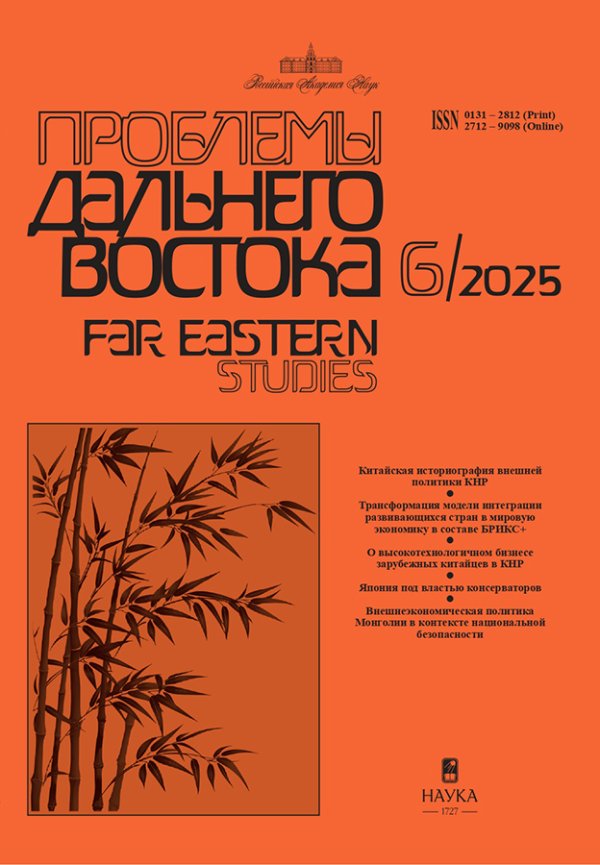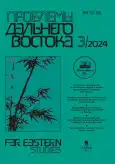China's Financial Liberalization: Specific Aspects and Effects6
- Authors: Rakov I.D.1
-
Affiliations:
- State Academic University for the Humanities (GAUGN)
- Issue: No 3 (2024)
- Pages: 84-100
- Section: Economics
- URL: https://journals.rcsi.science/0131-2812/article/view/264129
- DOI: https://doi.org/10.31857/S0131281224030065
- ID: 264129
Full Text
Abstract
The article is devoted to studying financial liberalization in China. The study is identified the main stages of financial liberalization and its adjustments depending on internal and external circumstances. A new international financial crisis is growing and has already begun to affect China's economy. A comparative analysis of China and the G20 developing countries was carried out in terms of financial openness and financial integration into the global financial system, cryptocurrencies regulations and digital national currency, features of economic policy and the state of the external financial sector. China's liberalization policy began with the removal of restrictions on foreign direct investment and the current account. The priorities of the financial liberalization policy is changed by reason of the economy grows and develops: from domestic economic development to the financial expansion of other countries in order to gain access to new markets and technologies. But most restrictions on the movement capital remain in China. The use of cryptocurrencies as an opportunity to circumvent currency restrictions is legally prohibited, and instead an attempt is being made to impose a national digital currency on society. The degree of government participation in the economy plays an important financial liberalization. Comparing other developing countries, China has a much higher degree of government involvement in the economy. This allows to maintain macroeconomic stability within the country even during international financial and economic crises. It is concluded that a gradual and partial financial liberalization with the maintaining domestic macroeconomic stability will provide the best results.
About the authors
Ivan D. Rakov
State Academic University for the Humanities (GAUGN)
Author for correspondence.
Email: rid2354@mail.ru
ORCID iD: 0000-0002-9864-9873
Ph.D. (Economics), Researcher of Centre for Legal Research of Digital Technologies
Moscow, RussiaReferences
- Островский А.В. Мировой финансовый кризис и его влияние на китайскую экономику // История Китая с древнейших времен до начала XXI века / Под ред. А.В. Виноградова. Т. IX. Реформы и модернизация (1976–2009). Москва: Наука, 2016. C. 672–674.
- Раков И.Д. Теоретические концепции финансовой либерализации // Финансы и кредит. 2019. T. 25. № 8 (788). C. 1933–1948. doi: 10.24891/fc.25.8.1933
- Раков И.Д. Влияние финансовой либерализации на экономики развивающихся стран: дис.… канд. экон. наук: 5.2.5. М.: Российский экономический университет имени Г.В. Плеханова, 2023. 239 с.
- Решетникова М.С. Трансформация инвестиционной стратегии КНР в условиях нарастания глобализации инвестиционной деятельности // Микроэкономика. 2013. № 1. С. 105–109.
- Савинский С.П. Цифровая валюта Китая и интеграция цифровых валют стран БРИКС // Банковское дело. 2022. № 11. C. 31–37.
- Санникова Л.В. Правовые основы цифровых валют центральных банков и цифрового рубля // Финансовый журнал. 2023. T. 15. № 5. C. 27–44. doi: 10.31107/2075–1990–2023–5–27–44
- Eichengreen B., Xia G. China and the SDR: Financial liberalization through the back door // Quarterly Journal of Finance. 2019. Vol. 9. No. 03. Pp. 1–36. doi: 10.1142/S2010139219500071
- Gang Y. China's Interest Rate System and Market-Based Reform of Interest Rate // Journal of Financial Research. 2021. Vol. 495. No. 9. Pp. 1–11.
- He Q. Gradual financial liberalization, FDI, and domestic investment: evidence from China's panel data // The Journal of Developing Areas. 2012. Vol. 46. No. 1. Pp. 1–15.
- Jinyue D., Le X. China's Financial Liberalization: Time to Restart // China Economic Watch. 2018. Pp. 1–6. URL: https://www.bbvaresearch.com/wp-content/uploads/2018/05/201805_China-FinancialLiberalization_edited.pdf (дата обращения: 10.04.2024).
- Jun Mao, Hui Miao. Chapter 14. The Impact of Financial Liberalization on China’s Financial Sector // China's Road to Greater Financial Stability China's Road to Greater Financial Stability: Some Policy Perspectives / ed. Das U.S., Fiechter J., Sun T. Washington: International Monetary Fund, 2013. Pp. 191–199.
- Kruger M., Pasricha G.K. What to expect when China liberalizes its capital account. Staff Discussion Paper. Ottawa: Bank of Canada, 2016 // Handle.net. URL: https://hdl.handle.net/10419/173363 (дата обращения: 21.03.2024).
- Lam M. W.R., Lam W., Badia M.M.M. Fiscal policy and the government balance sheet in China // International Monetary Fund. August 4, 2023. 55 p. URL: https://www.imf.org/en/Publications/WP/Issues/2023/08/02/Fiscal-Policy-and-the-GovernmentBalance-Sheet-in-China-536273 (дата обращения: 04.04.2024).
- Lane P.R. Milesi-Ferretti G.M. International financial integration // IMF Staff Papers. 2003. Vol. 50. No. 1. Pp. 82–113. doi: 10.2307/4149916
- Li J., Liu M.-H. Interest rate liberalization and pass-through of monetary policy rate to bank lending rates in China // Frontiers of Business Research in China. 2019. Vol. 13. No. 1. doi: 10.1186/s11782–019–0056-z
- Ma J. Chapter 7. Interest Rate Transmission in a New Monetary Policy Framework // Modernizing China: Investing in Soft Infrastructure Modernizing China / ed. Lam W.R., Rodlauer M., Schipke A. Washington: International Monetary Fund, 2017. Pp. 191–213.
- Prasad E. Growth slows, risks abound, but economic and financial collapse can be avoided // International Monetary Fund. December 2023. URL: https://www.imf.org/en/Publications/fandd/issues/2023/12/China-bumpy-path-Eswar-Prasad (дата обращения: 30.04.2024).
- Tseng W.S., Tseng W.S., Rodlauer M. China China: Competing in the Global Economy. 5 Foreign Direct Investment in China: Some Lessons for Other Countries. International Monetary Fund, 2003. Pp. 68–88.
- Wong C. Plus ça Change: Three Decades of Fiscal Policy and Central—Local Relations in China // China: An International Journal. 2021. Vol. 19. No. 4. Pp. 1–31. doi: 10.1353/chn.2021.0039
- Yu Y. Débat 4 The Evolution of Capital Controls in China. Chinese Academy of Social Sciences, 2014. 11 p. // Le Cercle des économistes. URL: https://lesrencontreseconomiques.fr/2014/wpcontent/uploads/sites/2/2014/07/yu.y_theevolutionofcapitalcontrolsinchina.pdf (дата обращения: 21.03.2024).
- Zebregs H., Tseng W.S. Foreign Direct Investment in China: Some Lessons for Other Countries // IMF Policy Discussion Papers. 2002. Vol. 2002. No. 003. Pp. 2–25. doi: 10.5089/9781451974171.003.A001
- Zenglein M.J., Kärnfelt M. China's caution about loosening cross-border capital flows // Mercator Institute for China Studies. June 19, 2019. URL: https://merics.org/en/report/chinas-caution-aboutloosening-cross-border-capital-flows (дата обращения: 30.04.2024).
- Zhang C. How Much Do State-Owned Enterprises Contribute to China’s GDP and Employment? // World Bank. July 15, 2019. 11 p. URL: https://documents1.worldbank.org/curated/en/449701565248091726/pdf/How-Much-Do-StateOwned-Enterprises-Contribute-to-China-s-GDP-and-Employment.pdf (дата обращения: 01.05.2024).
- Zhang L. Capital account liberalization and China’s financial integration. M-RCBG Associate Working Paper Series No. 196. 2023.
- 徐义国: 金融自由化的最新进展: 经验推演及实践共识 [Сюй Иго. Новейший прогресс в финансовой либерализации: эмпирические выводы и практический консенсус] // 河北经贸大学学报. 2008年. 第3期.
- 中國大陸金融市場改革及其對台灣金融業之影響與挑戰 [Реформа финансового рынка материкового Китая, ее влияние и проблемы на финансовую индустрию Тайваня]. 計畫主持人: 黃志典. 台北市: 台灣大學國際企業學系暨研究所. 2016 年. 4 段 85 號. 128页. URL: https://www.tpefx.com.tw/uploads/download/tw/Financial%20Market%20Reform%20in%20China.pdf (дата обращения: 02.07.2024).










